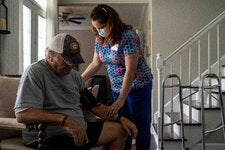Facing Financial Ruin as Costs Soar for Elder Care
The United States has no coherent system for providing long-term care, leading many who are aging to struggle to stay independent or to rely on a patchwork of solutions.
By Reed Abelson and


The United States has no coherent system for providing long-term care, leading many who are aging to struggle to stay independent or to rely on a patchwork of solutions.
By Reed Abelson and


Facing a severe shortage of aides and high costs, people trying to keep aging loved ones at home often cobble together a patchwork of family and friends to help.
By Reed Abelson and


The add-ons pile up: $93 for medications, $50 for cable TV. Prices soar as the industry leaves no service unbilled. The housing option is out of reach for many families.
By


The private insurance market has proved wildly inadequate in providing financial security for millions of older Americans, in part by underestimating how many policyholders would use their coverage.
By Jordan Rau and


‘I Wish I Had Known That No One Was Going to Help Me’
Adult children discuss the trials of caring for their aging parents: unreliable agencies, a lack of help and dwindling financial resources.
By Reed Abelson and

A Guide to Long-Term Care Insurance
Deciding when, or whether, to buy long-term care insurance can be complex. Here’s what to know.
By

What to Know About Assisted Living
The facilities can look like luxury apartments or modest group homes, and can vary in pricing structures. Here’s a guide.
By

What to Know About Home Care Services
Finding an aide to help an older person stay at home safely takes work. Here’s a guide.
By

What Long-Term Care Looks Like Around the World
Most countries spend more than the United States on care, but middle class and affluent people still bear a substantial portion of the costs.
By

Advertisement

Thousands of people shared their experiences and related to the financial drain on families portrayed in the Dying Broke series.
By Jordan Rau and Reed Abelson

Most Americans are unprepared to deal with the soaring costs of long-term care.
Advertisement
Advertisement